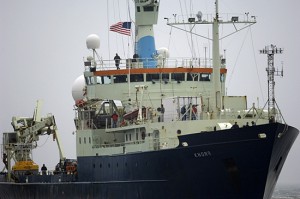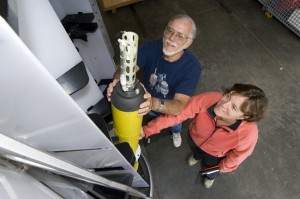Local Time: 1545
Position: 44 03ºN, 63 23ºW (about 35 miles from Halifax)
Weather: Partly sunny
Sea state: Calm
Air temperature:62ºF, 16ºC
Today's Audio Postcards (mp3 format)
» A conversation with Jim Valdes, engineer, on setting up floats before launch
» A trip to the bridge
» Amy Bower talks to Captain Kent Sheasley about the view from Knorr's bridge
» Find out what's for dinner
Today's Journal
Wow. The weather could not be better! It’s relatively mild and there are almost no waves. Technicians Will Ostrom and Jim Valdes are working on preparations for the mooring launch. It’s still several days away but as Will says “We might as well take advantage of the good weather—you never know when it might all go to heck!” They are getting the floats out of boxes, checking the float electronics and hitching up some of the sections of the mooring.
Last night was peaceful enough for great sleeping until about 0300. I awoke with a start. But it was quiet, and at first I couldn’t figure out why I had woken up. Then I heard it—the fog horn! It’s located right above my cabin and it’s REALLY loud. When the visibility is low, the mate on watch turns it on (it’s electronic, not a fog horn you have to blow into) and then it goes off automatically every two minutes. I lay awake for quite some time before I managed to fall asleep again. If this keeps up, I might look for an empty cabin on a lower deck!
Today we had our fire and abandon-boat drill. When the alarm sounded, we were all instructed to get our PFDs (that’s personal flotation device, otherwise known as a life jacket) and survival suits. We met in the main lab and the chief mate Dee went over all the safety information. She finished up by demonstrating how to get into the survival suit. It’s like an oversized wet suit only bright orange. It’s so big and floppy that some people call them gum bee suits.
Teacher Kate is assigned to be my safety “buddy”. In the event of an emergency, she will be in charge of making sure I’m with her. Because of my limited vision, it’s good for me to be with a fully sighted person in an emergency. This is the plan I worked out with Captain Kent. We also talked about making sure that I’m notified if any of the crew has to open a hatch in the floor.
I found out today that we will be going around the west side of Newfoundland to get to the Labrador Sea. This is a shorter route than going around the eastern side, and we will avoid the fog and stray icebergs that are often found on the Grand Banks of Newfoundland. We will first pass through Cabot Strait, located between Cape Breton Island in Nova Scotia and Newfoundland, and then through the Straits of Belle Isle, located between the northern tip of Newfoundland and Labrador. I expect we will see more ship traffic and perhaps even see land!



